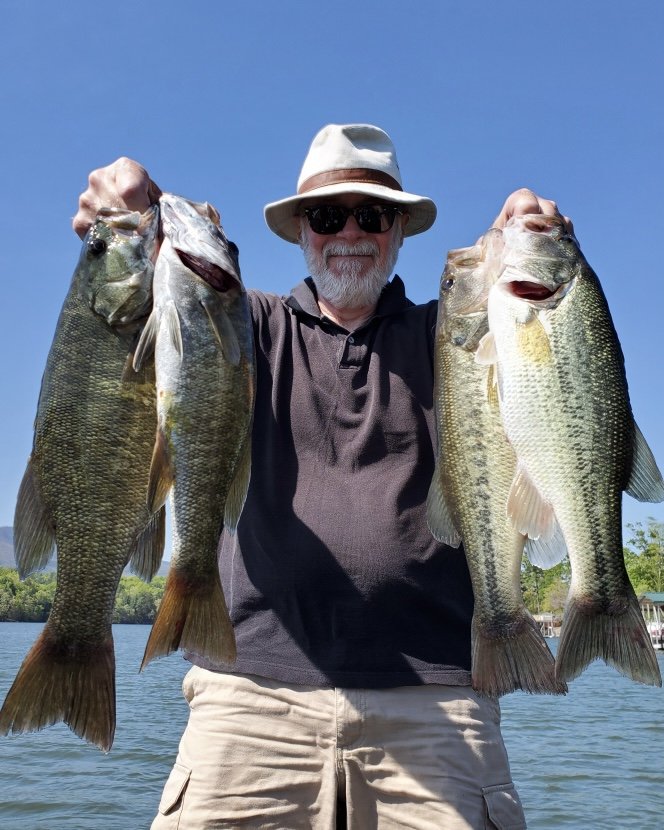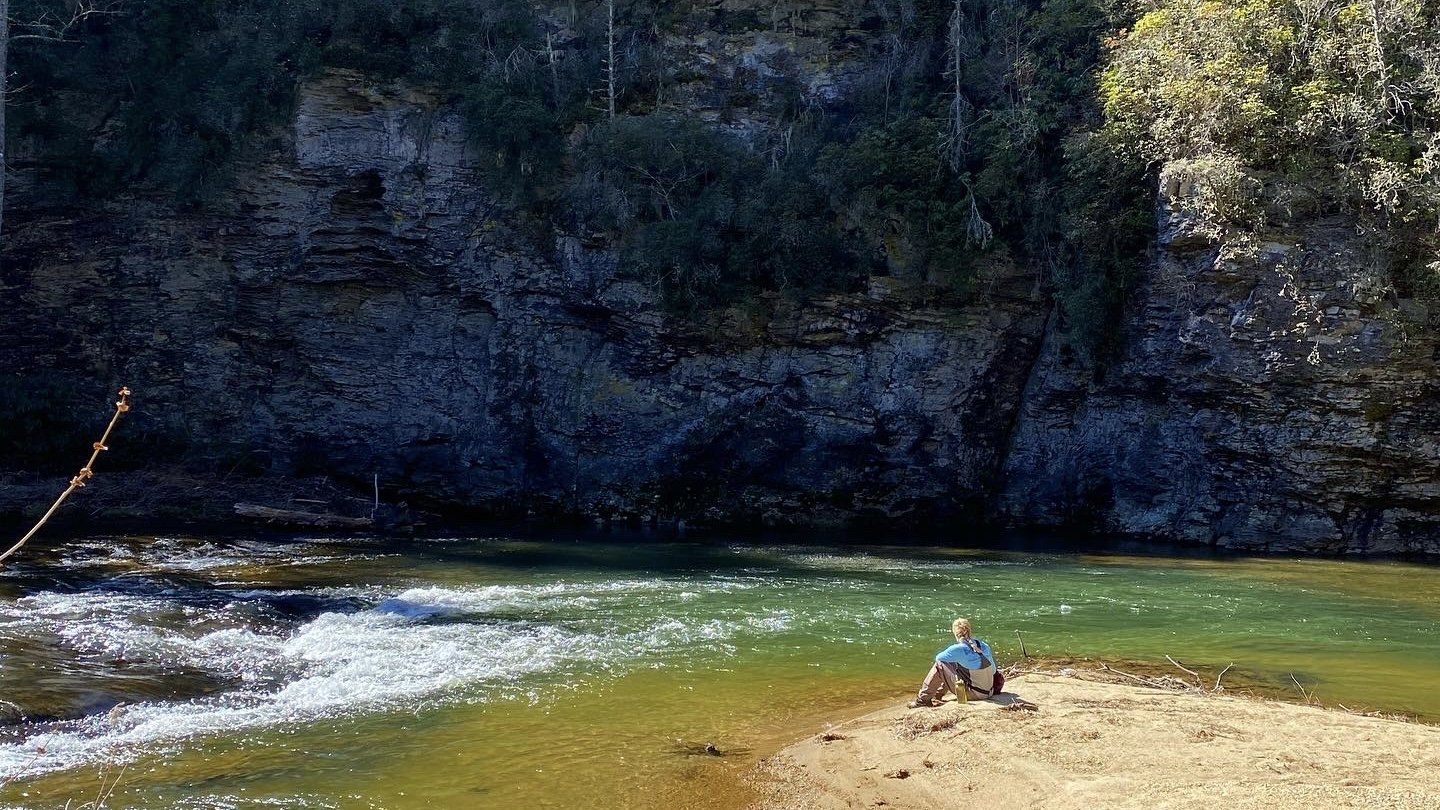North Carolina is home to the largest mountains on the the east coast and this produces great trout fisheries, smallmouth rivers, and mountain lakes. North Carolina is home over 2,000 miles of cold water creeks and rivers that support trout. There are plenty of trout streams in the Pisgah National Forest that have natural reproduction, but some of the lower elevation fisheries that are incapable of supporting wild trout receive stockings of hatchery raised fish that presents angling opportunities. North Carolina boasts some really good tailwater fisheries which include the Tuckaseegee, Catawba, Nantahala, and the Green. These tailwaters consistently produce some of the biggest trout caught in North Carolina. Trout aren’t the only species worthy of targeting when visiting the mountains of North Carolina. The French Broad River near Asheville and the Toe River near Spruce Pine are highly regarded for their smallmouth populations. Asheville fishing guides have done extremely well targeting these great sport fish. These two larger rivers hold musky as well which are among the largest North American fish living only in freshwater. North Carolina is home to some larger lakes which create some excellent angling opportunities throughout the year. Lake James is home to smallmouth and largemouth bass which draws in anglers all across the state to fish it. The state record Tiger Muskellunge was caught out of Lake James in the 80’s and there remains a dedicated group of musky anglers that chase these fish in the Catawba and Linville Rivers that feed the lake. Speaking of Linville, the Linville Gorge has been named the Grand Canyon of the East and is one of the only two wilderness areas in North Carolina. This rugged wilderness is home to some large brown trout and smallmouth bass. This area should be explored only if you have experience in the backcountry because it is no place for novices. Below we will highlight some areas and fisheries worthy of exploring in North Carolina. Thanks for taking the time to read.
Pisgah National Forest:
The Pisgah National Forest is home to some of the best trout fishing in North Carolina. Davidson River, South Toe River, Wilson Creek, Curtis Creek, and the South Mills River are all within the Pisgah National Forest. The tributaries that flow into these creeks and rivers are noteworthy for their wild trout populations. Most of these tributaries are smaller and many anglers overlook them because of their size. These smaller creeks are seldom fished and can hold healthy populations of surprisingly large, spooky fish. The ability to make short, accurate casts is imperative to success here. Most wild trout streams in North Carolina are around the 2,000 foot elevation mark which offers great scenery and solitude. There is nothing like casting a dry fly in early Spring to wild trout in a backcountry setting. This is truly a genuine Southern Appalachian fly fishing experience. The best time to target wild trout in North Carolina is from late February to early December. These higher elevation creeks get really cold in late winter and anglers have a short window to target these fish only in late afternoon. If you have never experienced a March Brown hatch in April on one of the wild trout streams in North Carolina then make an effort to do so.
Bridgewater Tailrace:
If you aren’t interested in tight corner fishing on the smaller mountain creeks of North Carolina then the tailwaters might spark your interest. Tailwaters are notoriously known for growing very large trout. The Bridgewater Tailrace extends from Lake James to Lake Rhodhiss which provides 18 miles of fishing. Most anglers devote their time and effort to catching trophy trout in the upper 8 miles of the Tailrace, but old timers say the biggest trout hang around the lower end of the tailwater near Morganton. Shockings in the Tailrace has proven that the fishery holds some giant trout. Trout up to 28 inches have been shocked in the fishery and striper anglers regularly catch browns exceeding 20 inches. The best way to catch a big brown in a tailwater is throwing large streamers. A big meal will entice the larger fish to move. The bigger brown trout in any body of water aren’t going to waste their time eating something small unless you encounter a specific hatch. Large brown trout hunt that one large meal that will hold it over for a day or two. The Bridgewater Tailrace’s worst enemy is Muddy Creek which dumps a ton of sediment in the fishery after extreme floods. The sediment can be detrimental to younger fish, but the more mature fish do have a fighting chance. Trophy brown trout are always present in this fishery, but in order to catch them one must be willing to put the time in year after year. The best time to fish the Bridgewater Tailrace is Early December to the end of May.
French Broad and Toe Rivers
The French Broad River and Toe River boast excellent smallmouth bass numbers which creates excellent angling opportunities from March to November. More and more anglers are giving the trout a break in the heat of the summer and focusing their attention on river bass. Smallmouth are some of the sportiest fish in North Carolina. They are aggressive fish that are known for their eyes being bigger than their stomachs. They hit big baits and are known for their ferocious topwater takes. The rocky bottoms and ledges of these two rivers provide the perfect hiding places for smallmouth bass to ambush their prey. Next time you are in western North Carolina try your hand at smallmouth instead of trout and I promise you won’t be disappointed. Catching a five pound smallmouth out of the river on light tackle or a fly rod is about as good as it gets in North Carolina.
Lake James:
Rivers aren’t the only place in North Carolina to find bass. Lake James is a very clean lake due to the fact that two mountain rivers flow fresh, cold water in to it. The lake is home to a variety of fish species but the most known species are smallmouth and largemouth bass. In order to fish the lake one must have a motorized boat or a kayak. If you plan on kayaking the lake devote your attention to where one of the four tributaries come into it. These include the Catawba River, Linville River, North Fork of the Catawba, and Paddy Creek. The Catawba River arms hold musky certain times of the year so if you are interested in chasing huge fish then this is your best bet. The Catawba River is a unique river holding numerous species unlike any other river in North Carolina. Depending on the season you can catch trout, smallmouth, largemouth, catfish, walleye, and perch. This makes the Catawba River a one in a kind fishing experience. We will discuss it in further detail below. Lake James fishes best in the Spring, but people fish it year round. One tip here is to find the baitfish. The bass are constantly chasing the blueback herring on this lake.
Catawba River
The Catawba River flows through 9 counties in North Carolina and provides ample opportunities to catch a variety of species. The Catawba River headwaters start in McDowell County then flows east through a series of lakes and eventually into South Carolina. In between the lakes provides great habitat for fishing. The Catawba River is easily navigable with a kayak or raft which makes it very appealing to a lot of anglers. The Catawba River provides plenty of wading opportunities through McDowell and Burke Counties. There are a few greenways on this river that gets stocked with trout certain times of the year. The river has something for everyone whether you are looking for trout or bass. The Catawba River is a lower elevation fishery which creates a great place to chase trout in the colder months when the higher elevation fisheries are too cold to fish.
Linville Gorge Fishing
The Linville Gorge is rugged, wild, big, and just plain awesome! It is a wilderness area and it’s a place worth exploring whether you fish or not. The scenery is just as good as the fishing. If you plan on fishing Linville Gorge then you need to have some experience in the backcountry. Fishing the gorge is challenging because of all the rock hopping you have to do to get to certain holes. There are some massive holes in the gorge and you will quickly notice why big fish like it here. Big brown trout and smallmouth bass lurk in the Linville River. The greater the risk the greater the reward. If you are looking for a challenge this is the place to go.
Thanks for taking the time to read this article. If you have any more questions about where to fish in North Carolina then just give us a call and we can provide more details that we prefer not to post online. Tight lines!




















